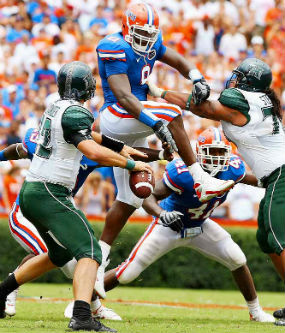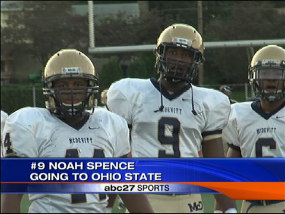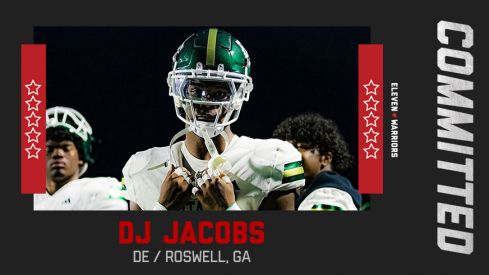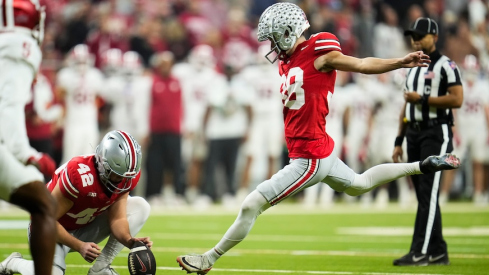 Carlos Dunlap, one of Meyer's most athletic DEs
Carlos Dunlap, one of Meyer's most athletic DEsIn today's Stat Session, I'll be taking a look at the first defensive position group in this series, following my previous analyses of tight ends and running backs.
So far I've concentrated on offensive positions because we can generally expect more differences in offensive skill positions than any other area of the team. Most notably, Ross has introduced us to offensive pivot players, including hybrid TE/FB/WRs and WR/RBs.
In contrast, we can expect a much greater degree of continuity from the Fickell and Withers-led defense. In fact, Heacock and Fickell's defenses have been employing hybrid defensive positions and looks for years in order to counter the rise of the spread offense in the Big Ten.
We can largely expect more of the same, albeit with more quarters coverage, under Meyer in the future.
Many argue that Urban's success at Florida, and the SEC's recent dominance more broadly, was largely built upon superior defensive line play. After witnessing this first hand out in Glendale in 2007, it's hard for Ohio State fans to argue with this analysis (sorry for bringing it up, everyone).
The NFL certainly agrees that Florida's defensive linemen were elite, with 3 defensive tackles and four defensive ends currently on NFL rosters.
Urban's emphasis on the defensive line was exceedingly evident in his first recruiting class at Ohio State, with four defensive linemen at an average 6.0 rivals rating. That means the class just about averaged five stars on the defensive line.
My dataset is comprised of all UF defensive linemen in Urban's two-deep between 2006 and 2010. You may access my dataset here.
I'm primarily interested in Urban's defensive linemens' physical attributes, production, and correlation with success. More specifically, just how elite were Urban's defensive linemen and can we expect any quantifiably significant differences under Urban's reign?
Physical Attributes
Beginning with some basic physical statistics, Urban's defensive ends average 6'4.2" (with a standard deviation of 1.4 inches) and were an average of 258 pounds.
His defensive tackles average 6'2.6" (with a standard deviation of 1.8 inches) and were an average of 294 pounds. The relatively high standard deviations can be roughly accounted for by the small samples sizes.
 Noah Spence wants to be Urban's next superior DE
Noah Spence wants to be Urban's next superior DEThe stereotype for most of Urban's defensive linemen (and the SEC's more broadly) was that speed was a more prized attribute than size, and the data certainly supports this for defensive ends, but not for defensive tackles.
In his classic Finding the Winning Edge, Bill Walsh lists his ideal defensive end as 6'5" and 275 pounds and his ideal defensive tackle as 6'2" and 290 pounds. Urban's defensive tackles are almost exactly the same size as Walsh's NFL ideal, reflecting the fact that tackles generally have to meet a certain size requirement (especially weight) to be effective in the interior.
Defensive ends, on the other hand, are able to have a bit more variability. Urban's ends are typically a bit shorter and a bit lighter than Walsh's NFL ideal, though he does not distinguish between strong and weakside ends in his analysis.
Urban has a smaller average defensive end because of the typically smaller and faster weakside end position, or LEO (sometimes VIPER if primarily standup OLB).
Production
A couple of things stand out when looking at Urban's defensive linemen in total:
First, Derrick Harvey, Jermaine Cunningham, and Carlos Dunlap (along with Jarvis Moss in 2006) were as elite as they come. These guys averaged double digits in TFLs and over seven sacks a season - elite numbers, even without looking at less-quantifiable metrics like quarterback pressure.
Meyer generally had one older and one underclassman put up big numbers at end each season. There was no clear relationship between size and statistical production at DE, however. Jermaine Cunningham was one of the "smaller" (6-3 and 250) DEs that we might initially associate with the idea of speedy SEC linemen, while Dunlap was both huge and fast, at 6-6 and 290.
Furthermore, while SEC defensive lines are known for their great depth and ability to constantly rotate linemen with little drop off in production, there was certainly a statistical drop off between the first and second string DEs. The second stringers rarely recorded more than 20 tackles or more than 2 sacks on the season, though this is likely just a function of variations in playtime.
Further, hitting the two-deep as a freshman predicted a defensive linemen's future success almost perfectly. Urban has said,
We don't redshirt here at Ohio State. We're changing that up. We're going to have the culture out here that there's no redshirting. If you don't play here, it's because you're not good enough. It's not because we're holding you back. We're going to recruit the kind of player where we want them on the field right now.
and this certainly seemed to be true for Meyer at Florida. If you've got the talent, you'll be on the two-deep, at least on his defensive line. Note, that doesn't necessarily guarantee huge numbers as a freshman, just "flashes." For instance, Carlos Dunlap cracked the two-deep as a freshman, but only put up one sack in 2007. The next year, along with gaining 50 (!) pounds, Dunlap added 39 tackles, 13.5 of which were for loss, and 9.5 sacks.
Predictions
These findings have several implications for our Buckeyes next year if Meyer's past trends continue.
We'll likely see some of the elite freshmen hit the two deep. That's not a super bold prediction, but considering how amazingly deep this group of linemen is, it would be nothing short of amazing for a freshman to line up next to Hankins, Simon, Bennett, and the like.
The freshmen aren't likely to produce killer numbers until their sophomore years, with the possible exception of Noah Spence, who has the potential to seize control of the LEO spot. I hesitate to speed up the hype train for this kid (as that's always a dangerous game), but if there's any position that really needs bodies on the line, it's at rush end.
Otherwise, we're likely to see Meyer continue to recruit extremely similar looking tackles as we're used to. Heacock and Fickell were big fans of versatility on the line - Simon has lined up at almost every position, and even Big Hank has played some end - but Meyer's teams do have a quantifiable size difference between ends and tackles. It's possible we'll see this trend continue in the future, with Meyer loving the speed of guys like Pittman, Spence, and even Washington (though he might be a SDE when it's all said and done).

